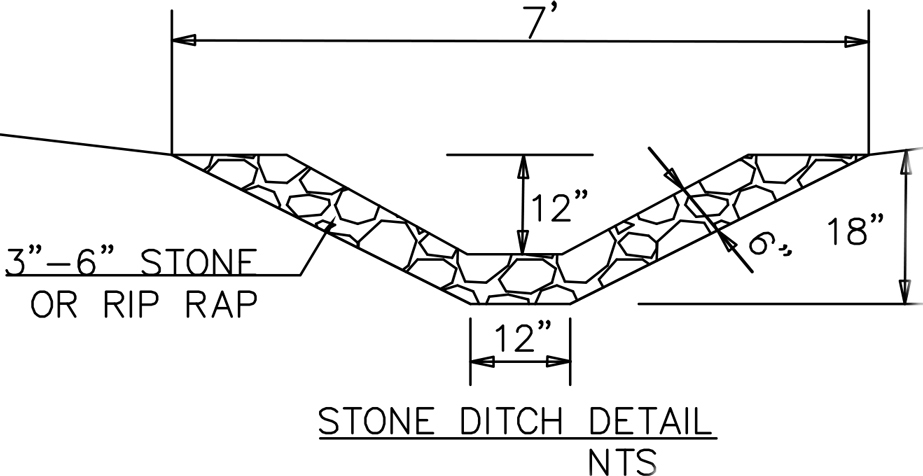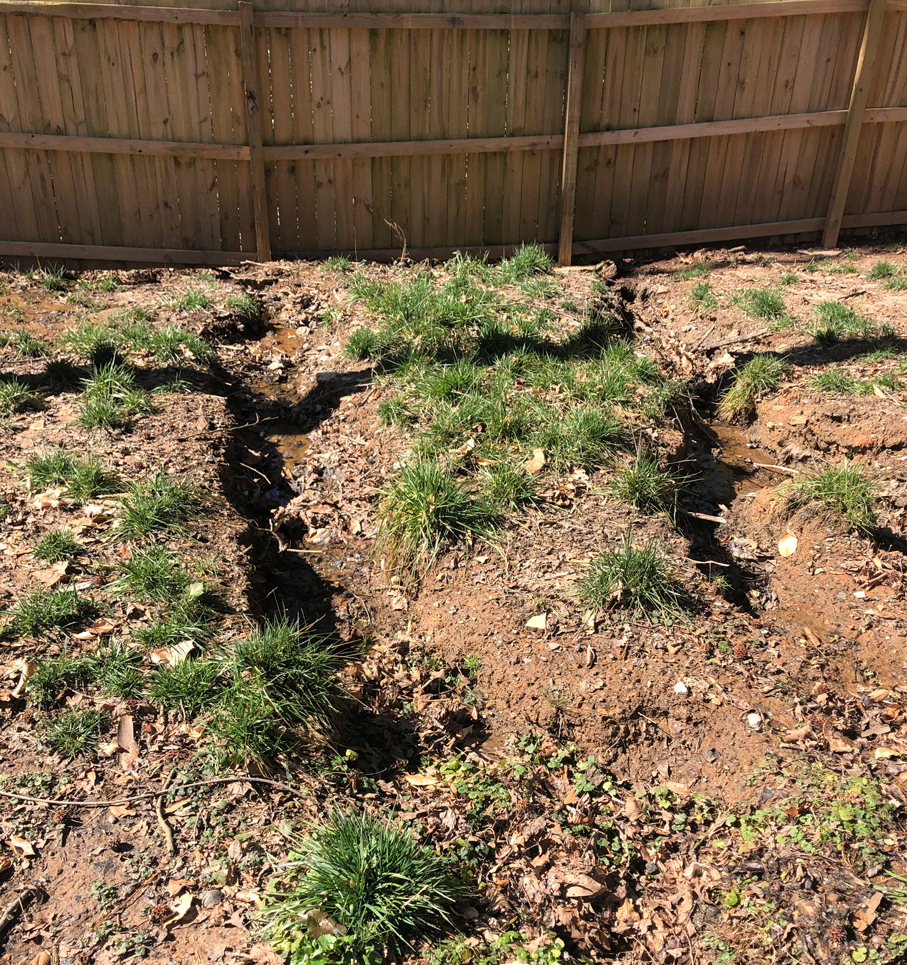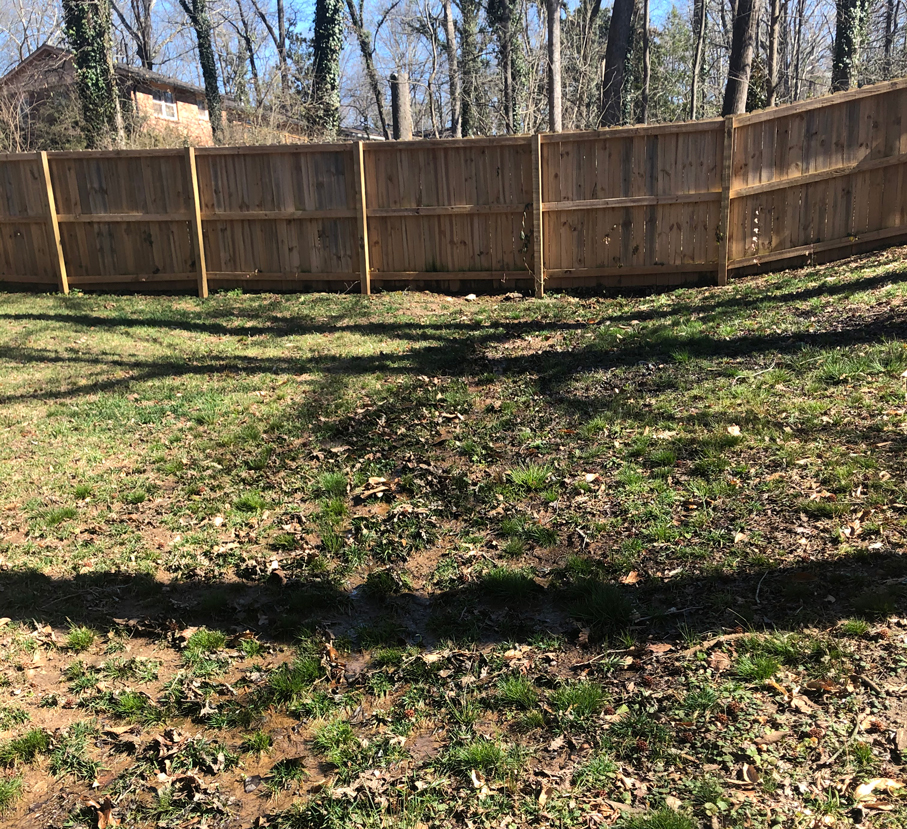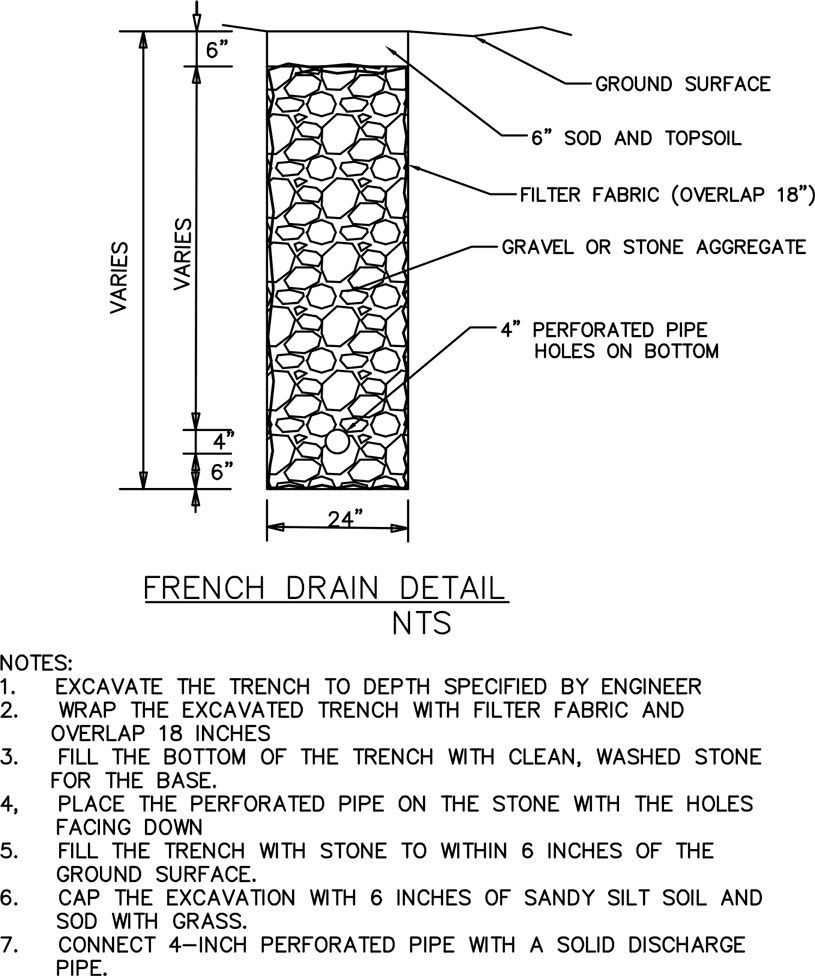For service in the Atlanta, Georgia area contact or call us:
Stormwater Drainage Swales
in Atlanta and Georgia
Stormwater drainage swales are easy to construct and can be completed during a couple of weekends. They collect runoff from the yard and direct it to a safe outlet location.

Stone Ditch Swale Detail
You can build small stormwater drainage swales yourself. Swales work best in relatively flat yards. If your yard is hilly or the stormwater may flow onto the neighbor's property, consult an engineer to assist in the design. The construction of the swale must not erode the property downstream. Also, let your downstream neighbor know what you plan to do in your yard. Since water flows downstream, the excess stormwater will flow onto the downstream property.
If you require a large swale, you should consider hiring a contractor with earth-moving equipment. Consult a local landscape contractor or a civil engineer if the topography requires design considerations such as steep slopes and properties with septic tanks nearby.
A swale should carry water to a place where it can be released safely, such as a garden bed with good drainage or a buried dry well. Garden beds allow the stormwater to be absorbed on-site rather than flow onto the neighbor's property.
Most small grass swales are less than 18 inches deep, with a flat bottom of approximately 18 inches wide. The sides of the swale should slope on a 3 to one. Gentle slopes allow for easy mowing.
Absorption Swales
Another environmentally friendly swale is the absorption swale. The purpose of this swale is to allow the stormwater time to absorb into the soil.
You should have your soil checked to determine if the soil will absorb the stormwater. The soil should drain quickly at a rate of approximately ½ inch per hour. If the soil percolates less than this, add compost to the swale's bottom to increase the absorption rate.
For soils with slower percolation rates, replace the soil with 65 percent screened sand and 35 percent compost. Have your engineer determine the size and depth of the swale. If the swale itself can't be made big enough to handle all the water, consider excavating the swale another 12 to 15 inches.
For larger absorption swales, line the trench with filter fabric and install a perforated pipe covered with stone or gravel. Place gravel under and around the pipe.
These stormwater drainage swales work with the perforated pipe to move water underground. The swale collects the surface water, and the water infiltrates into the perforated pipe in the trench. The storm drainage pipe then carries the water away from the area. Consider this combination in areas with high rainfall and sites with large amounts of stormwater runoff.
 |
 |
Benefits of Stormwater Drainage Swales
Buried drainage systems effectively
move water in beautifully landscaped yards because of their speed and
efficiency. Moving water too quickly can lead to flooding downstream. Thus, the
use of grass and rock swales have become more popular
Municipal governments encourage the use of swales because swales allow water to
infiltrate slowly. There are situations where underground piping is necessary
because of the large quantity of water to be moved. Your engineer will help you
determine when swales are best and when underground piping is required.
Municipalities are looking at ways to decrease the runoff going into the stormwater
systems.
Swales
are an environmentally friendly way to move and infiltrate water and can have
many forms and functions within the home landscape, depending on the soil and
climate conditions. Infiltration rates (percolation rates) are a measurement of
how fast water flows through the soil. The rate is dependent on the soil texture
and the quantity of water available. Saturated soils influence the infiltration
rate of soils.
Swales for infiltration are best for areas with soil that has a high
infiltration rate. With a very gradual slope, a swale can move water and allow
some infiltration into the ground. Using a swale for infiltration helps reduce
the overall runoff from a property.
Stormwater Drainage Swales for Landscaping
Stormwater drainage swales are an environmentally friendly way to move and infiltrate water
and can have many forms and functions within the home landscape, depending on
the soil and climate conditions. Infiltration rate is a measurement of how fast
water flows through soil and relies on various factors, including soil texture,
the amount of water coming in, and how saturated the ground is.
Swales for infiltration are best for areas with soil that has a high
infiltration rate. With a very gradual slope, a swale can move water and allow
some infiltration into the ground. Using a swale for infiltration helps reduce
the overall runoff from a property.

The Location Placement of Swales
Consult with your engineer to determine the best layout for your swale. He will decide if the swale should be straight or curved through your yard. The swale must be sloped and sized to accommodate rainfall for your location.
In areas of high volumes of water, rock dams may be needed to slow the water. Straight stormwater drainage swales carry a larger amount of water while curved swales meander around your yard, slowing the stormwater's velocity. The slower flow of water decreases erosion at the exit point.
If we can assist you with your stormwater drainage design, please call Atlanta Engineering Services at 770-316-1720 or email us at ela@atlantaeng.com
The American Institute of Hydrology has detail information about stormwater drainage swales for many parts of the country.
Other Stormwater Articles. . .
Groundwater Springs in Atlanta
Common Stormwater Drainage Problems in Atlanta
Find a Drainage Specialist for drainage consultation
Yard Drainage Problems Devalues Property
Simple Solutions to Residential Drainage Problems
Learn the Benefits of Stormwater Drainage Swales
Solving Wet, Soggy Yard Problems
Preventing Crawl Space Drainage Issues
Stormwater Damage from the Property Upstream
Stormwater Utilities and Detention Ponds
Forensic Hydrologist Evaluates Stormwater Runoff
Hydrology Expert Contact Information
Additional Services by Atlanta Engineering Services
G-ZNJ8QW23K9